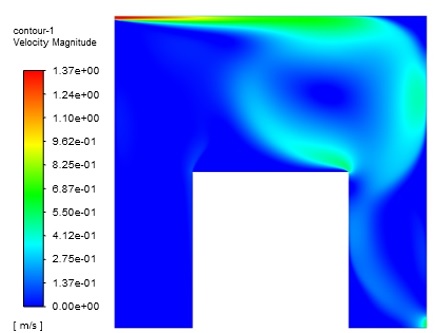Flow Analysis of Various Inlet Velocity Profiles on Indoor Temperature for Energy Conservation of HVAC System Using CFD
Abstract
Energy conservation has been the most popular topic of the modern world. Heating, Ventilation and Air Conditioning (HVAC) systems consume approximately 10 % of the total energy of world. In order to improve the efficiency of HVAC systems, two dimensional (2D) room with inlet, outlet and heat source has been modeled. ANSYS Fluent has been used for numerical analysis of air flow in a 2D room. User Defined Functions (UDFs), which are coded in C language and hooked in ANSYS fluent, have been used for recording temperature variations and for heat generation within 2D room. Besides studying velocity fields and temperature distributions within indoor environment under specified boundary conditions, reference region for comparative analysis is also selected during Steady State (SS) numerical simulations. During transient analysis, temperature variations of a selected location are recorded for four different scenarios under varying inlet velocity profiles i.e. three for 0°, 30°, 60° angle with 1.3661 m/s velocity and fourth 0° with 2.7322 m/s velocity. Temperature profile of reference region after 1500 sec of transient simulations are compared with the steady state. Temperature profile of the scenario once the air is injected at 30° closely matched with the steady state temperature profile of the selected region. Time for attainment of SS temperature is also measured and compared after transient simulations. SS temperature value was attained twice, first at 240 seconds when the air was injected at 0° with 2.7322 m/s and secondly at 522 seconds when inlet air entered at velocity of 1.3361 m/s at 30°. The power consumption by increasing the fan speed is much higher as compared to the power consumed for changing direction only.
References
K. Horikiri, Y. Yao, and J. Yao, “Numerical simulation of convective airflow in an empty room,” “Int. J. Energy Environ” 2011, vol. 5, no. 1, pp. 574–581.
J. Ni and X. Bai, “A review of air conditioning energy performance in data centers,” “Renew. Sustain. Energy Rev.” 2017, vol. 67, pp. 625–640.
P. Fang, T. Liu, K. Liu, Y. Zhang, and J. Zhao, “A simulation model to calculate temperature distribution of an air-conditioned room,” “Proc. - 2016 8th Int. Conf. Intell. Human-Machine Syst. Cybern. IHMSC” 2016, vol. 1, no. 2, pp. 378–381.
E. Mesenhöller, P. Vennemann, and J. Hussong, “Unsteady room ventilation – A review,” “Build. Environ.” 2020, vol. 169.
A. Raczkowski, Z. Suchorab, and P. Brzyski, “Computational fluid dynamics simulation of thermal comfort in naturally ventilated room,” “MATEC Web Conf.” 2019, vol. 252, p. 04007.
S. Schiavon and A. K. Melikov, “Energy saving and improved comfort by increased air movement,” “Energy Build.” 2008, vol. 40, no. 10, pp. 1954–1960.
M. Wang and Q. Chen, “Assessment of various turbulence models for transitional flows in an enclosed environment (RP-1271),” “HVAC R Res.” 2009, vol. 15, no. 6, pp. 1099–1119.

Published
How to Cite
Issue
Section
License
Copyright (c) 2022 50Sea

This work is licensed under a Creative Commons Attribution 4.0 International License.




















